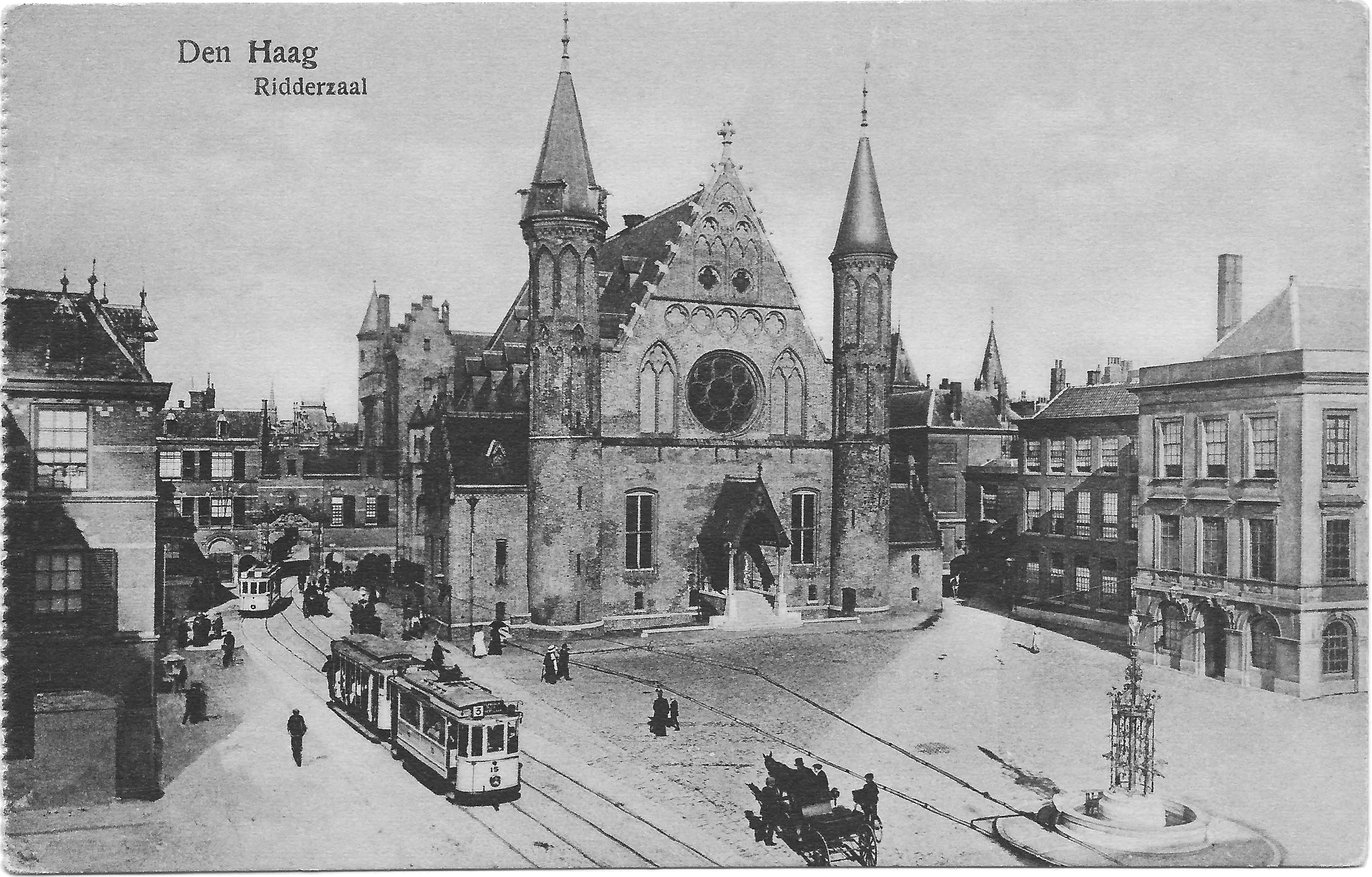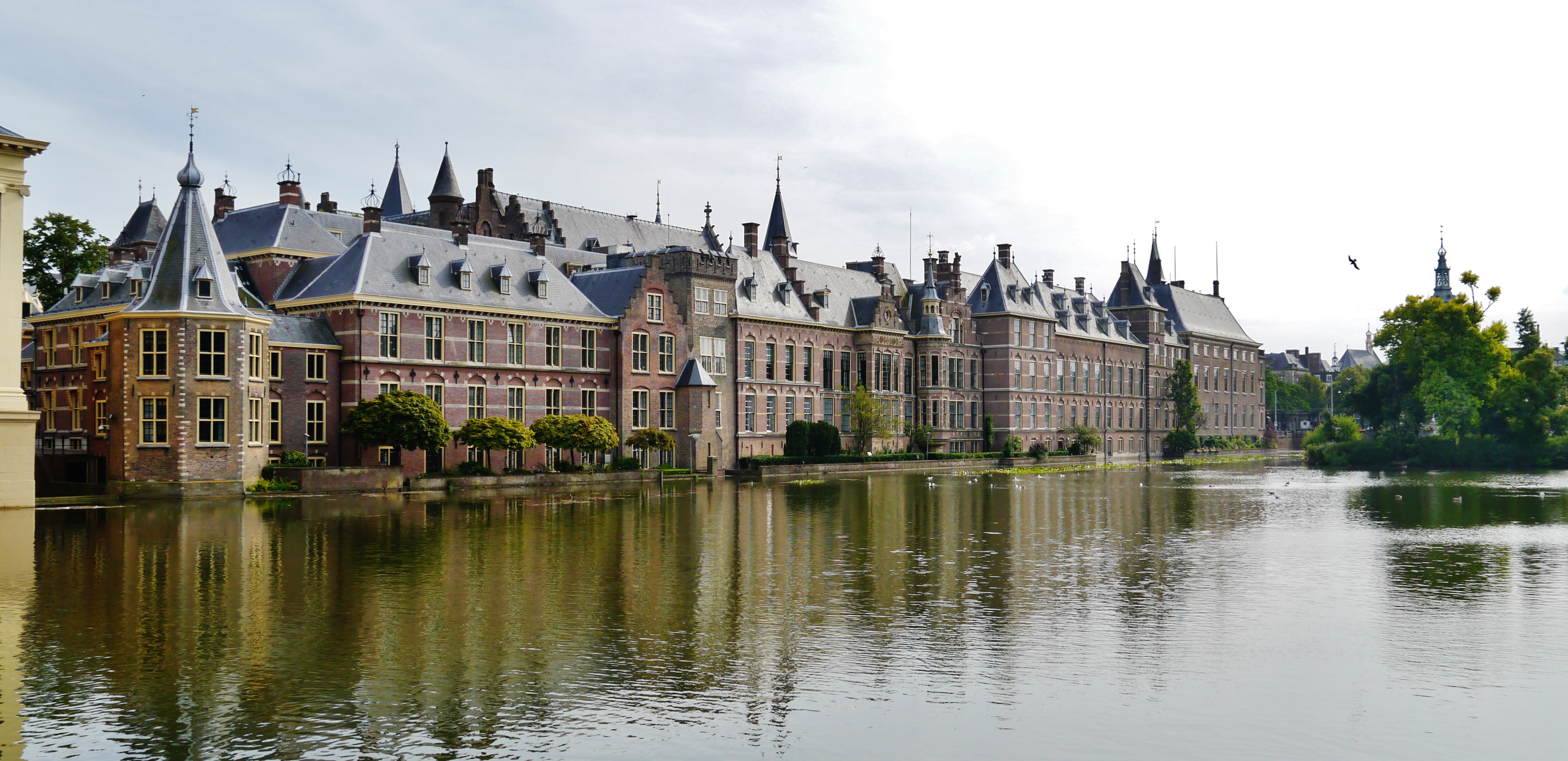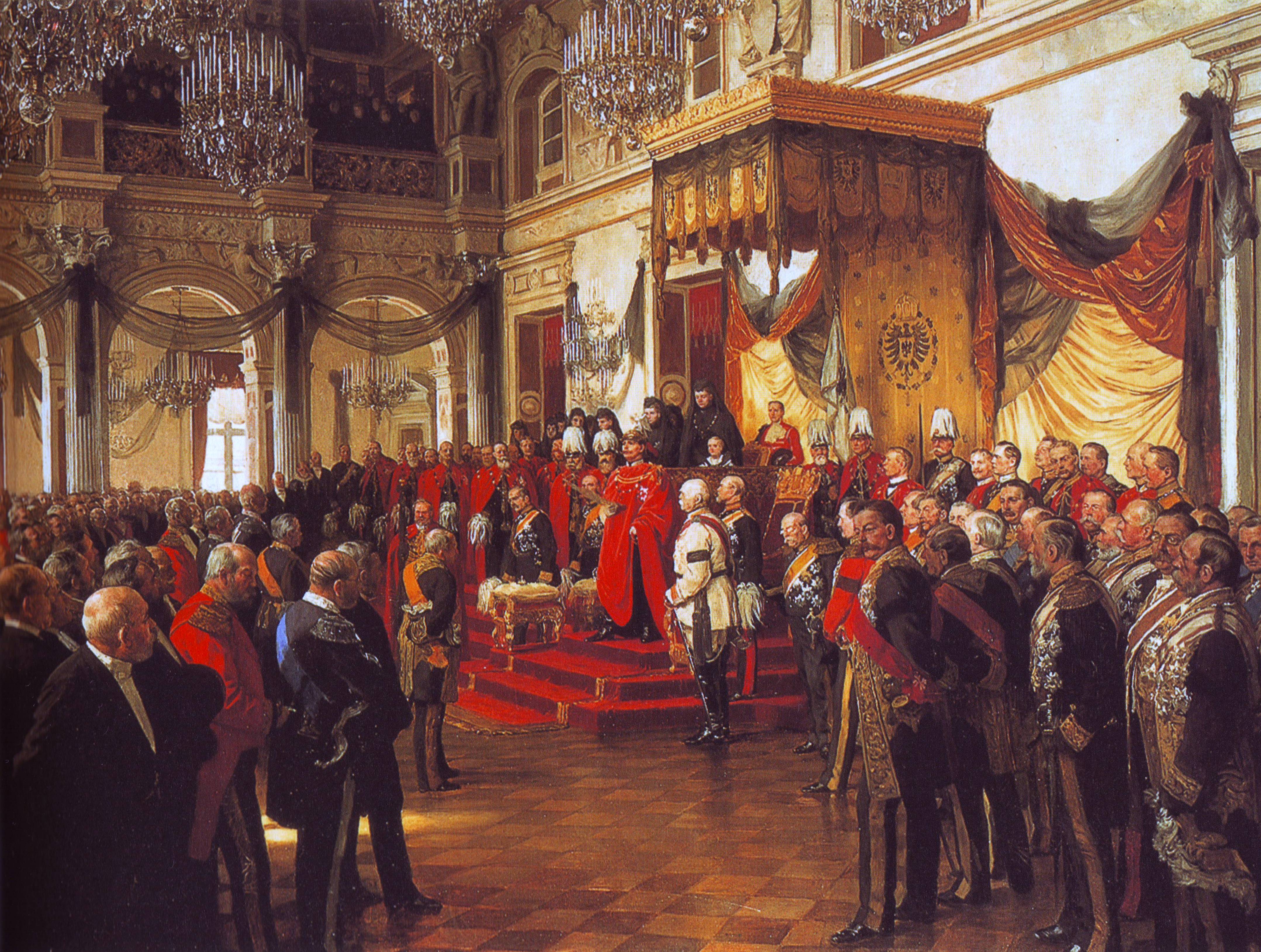|
Ridderzaal
The Ridderzaal (; en, Hall of Knights) is the main building of the 13th-century inner square of the former castle of the counts of Holland called Binnenhof (English: Inner Court) at the address Binnenhof 11 in The Hague, Netherlands. It is used for the annual state opening of Parliament on Prinsjesdag, when the Dutch monarch drives to Parliament in the Golden Coach and delivers the speech from the throne. It is also used for official royal receptions, and inter-parliamentary conferences. History In the 13th century Floris IV, Count of Holland bought a piece of land next to a small lake to build a house on. The Ridderzaal, the manorial hall of Floris V, grandson of Floris IV, was built on this estate in the 13th century. Over the centuries, the government buildings developed around this lake and incorporated the Ridderzaal. From the early 17th century, the Ridderzaal became an important trading place for booksellers, as Westminster Hall was in London. In later centuries it se ... [...More Info...] [...Related Items...] OR: [Wikipedia] [Google] [Baidu] |
Binnenhof
The Binnenhof (; en, Inner Court) is a complex of buildings in the city centre of The Hague, Netherlands, next to the Hofvijver lake. It houses the meeting place of both houses of the States General of the Netherlands, as well as the Ministry of General Affairs and the office of the Prime Minister of the Netherlands. Built primarily in the 13th century, the Gothic castle originally functioned as residence of the counts of Holland and became the political centre of the Dutch Republic in 1584. It is counted among the Top 100 Dutch heritage sites. The Binnenhof is among the oldest Parliament buildings in the world still in use. History Little is known about the origin of the Binnenhof. Presumably, the grounds next to the Hofvijver lake, and the small homestead on it, were purchased by Count Floris IV of Holland from Meiland van Wassenaar in November 1229. Between 1230 and 1234 he had the homestead expanded to a small keep. After Floris' son and successor William II was cr ... [...More Info...] [...Related Items...] OR: [Wikipedia] [Google] [Baidu] |
Prinsjesdag
Prinsjesdag ( en, Little Prince's Day) is the day on which the reigning monarch of the Netherlands addresses a joint session of the States-General of the Netherlands (consisting of the Senate and the House of Representatives) to give the speech from the throne ( nl, Troonrede, similar to the annual US State of the Union). This speech sets out the main features of government policy for the coming parliamentary session. The occasion is prescribed by the constitution, article 65 of which states: "A statement of the policy to be pursued by the Government shall be given by or on behalf of the King or the Queen before a joint session of the two Houses of the States-General that shall be held every year on the third Tuesday in September or on such earlier date as may be prescribed by Act of Parliament." After the speech from the throne, the budget is later presented to the House of Representatives by the Minister of Finances. Speech from the Throne The first part of Prinsjes ... [...More Info...] [...Related Items...] OR: [Wikipedia] [Google] [Baidu] |
The Hague
The Hague ( ; nl, Den Haag or ) is a city and municipality of the Netherlands, situated on the west coast facing the North Sea. The Hague is the country's administrative centre and its seat of government, and while the official capital of the Netherlands is Amsterdam, The Hague has been described as the country's de facto capital. The Hague is also the capital of the province of South Holland, and the city hosts both the International Court of Justice and the International Criminal Court. With a population of over half a million, it is the third-largest city in the Netherlands, after Amsterdam and Rotterdam. The Hague is the core municipality of the Greater The Hague urban area, which comprises the city itself and its suburban municipalities, containing over 800,000 people, making it the third-largest urban area in the Netherlands, again after the urban areas of Amsterdam and Rotterdam. The Rotterdam–The Hague metropolitan area, with a population of approximately 2.6&n ... [...More Info...] [...Related Items...] OR: [Wikipedia] [Google] [Baidu] |
Dutch–Indonesian Round Table Conference
The Dutch–Indonesian Round Table Conference was held in The Hague from 23 August to 2 November 1949, between representatives of the Kingdom of the Netherlands, the Republic of Indonesia and the Federal Consultative Assembly, representing various states the Dutch had created in the Indonesian archipelago. Prior to this conference, three other high-level meetings between the Netherlands and Indonesia took place; the Linggadjati Agreement of 1947, Renville Agreement of 1948, and the Roem–Van Roijen Agreement of 1949. The conference ended with the cession of sovereignty to the United States of Indonesia. Background On 17 August 1945, Indonesian nationalist leader Sukarno declared Indonesian independence from Japan. The Dutch, who had been expelled in 1942 by the Japanese occupation of the Dutch East Indies, viewed the Indonesian leadership as Japanese collaborators, and wanted to regain control of their colony. The conflict between the Dutch and Indonesian nationalists de ... [...More Info...] [...Related Items...] OR: [Wikipedia] [Google] [Baidu] |
Congress Of Europe
The Hague Congress or the Congress of Europe, considered by many as the first federal moment in European history, was held in The Hague from 7–11 May 1948 with 750 delegates participating from around Europe as well as observers from Canada and the United States of America. The Congress, organized by Duncan Sandys and Józef Retinger, brought together representatives from across a broad political spectrum, providing them with the opportunity to discuss ideas about the development of European political co-operation. It was held under the auspices of the International Committee of the Movements for European Unity, subsequently to become the European Movement after the Congress. Important political figures such as Konrad Adenauer, Winston Churchill, Harold Macmillan, Sir David Maxwell-Fyfe, Pierre-Henri Teitgen, François Mitterrand (both ministers in Robert Schuman's government), three former French prime ministers, Paul Reynaud, Édouard Daladier, Paul Ramadier, Paul van Zeeland ... [...More Info...] [...Related Items...] OR: [Wikipedia] [Google] [Baidu] |
States General Of The Netherlands
The States General of the Netherlands ( nl, Staten-Generaal ) is the supreme bicameral legislature of the Netherlands consisting of the Senate () and the House of Representatives (). Both chambers meet at the Binnenhof in The Hague. The States General originated in the 15th century as an assembly of all the provincial states of the Burgundian Netherlands. In 1579, during the Dutch Revolt, the States General split as the northern provinces openly rebelled against Philip II, and the northern States General replaced Philip II as the supreme authority of the Dutch Republic in 1581. The States General were replaced by the National Assembly after the Batavian Revolution of 1795, only to be restored in 1814, when the country had regained its sovereignty. The States General was divided into a Senate and a House of Representatives in 1815, with the establishment of the United Kingdom of the Netherlands. After the constitutional amendment of 1848, members of the House of Representatives w ... [...More Info...] [...Related Items...] OR: [Wikipedia] [Google] [Baidu] |
Congres Van Europa In De Ridderzaal
A congress is a formal meeting of the representatives of different countries, constituent states, organizations, trade unions, political parties, or other groups. The term originated in Late Middle English to denote an encounter (meeting of adversaries) during battle, from the Latin '' congressus''. Political congresses International relations The following congresses were formal meetings of representatives of different nations: *The Congress of Aix-la-Chapelle (1668), which ended the War of Devolution *The Congress of Aix-la-Chapelle (1748), which ended the War of the Austrian Succession *The Congress of Aix-la-Chapelle (1818) *The Congress of Berlin (1878), which settled the Eastern Question after the Russo-Turkish War (1877–1878) *The Congress of Gniezno (1000) *The Congress of Laibach (1821) *The Congress of Panama, an 1826 meeting organized by Simón Bolívar *The Congress of Paris (1856), which ended the Crimean War *The Congress of Troppau (1820) *The Congress of Tucu ... [...More Info...] [...Related Items...] OR: [Wikipedia] [Google] [Baidu] |
Monarchy Of The Netherlands
The monarchy of the Netherlands is a constitutional monarchy. As such, the role and position of the monarch are governed by the Constitution of the Netherlands. Consequently, a large portion of it is devoted to the monarch. Roughly a third of the document explains the succession, mechanisms of accession & abdication to the throne, and the roles & duties of the monarch. This includes the formalities of communication between the States-General and the monarch's role in creating laws. The Kingdom of the Netherlands has been an independent monarchy since 16 March 1815, but its once sovereign provinces had been intermittently "governed" by members of the House of Orange-Nassau and the House of Nassau from 1559, when Philip II of Spain appointed William of Orange as stadtholder, until 1747. William became the leader of the Dutch Revolt and the independent Dutch Republic. As a stadtholder, he was followed by several of his descendants. In 1747, the function of stadtholder became ... [...More Info...] [...Related Items...] OR: [Wikipedia] [Google] [Baidu] |
Speech From The Throne
A speech from the throne, or throne speech, is an event in certain monarchies in which the reigning sovereign, or a representative thereof, reads a prepared speech to members of the nation's legislature when a session is opened, outlining the government's agenda and focus for the forthcoming session, or in some cases closed. When a session is opened, the address sets forth the government's priorities with respect to its legislative agenda, for which the cooperation of the legislature is sought. The speech is often accompanied with formal ceremony and is often held annually, although in some places it may occur more or less frequently, whenever a new session of the legislature is opened. Historically, when monarchs exercised personal influence and overall decision-making in government, a speech from the throne would outline the policies and objectives of the monarch; the speech was usually prepared by the monarch's advisers, but the monarch supervised the drafting of the speec ... [...More Info...] [...Related Items...] OR: [Wikipedia] [Google] [Baidu] |
Golden Coach (Netherlands)
The Golden Coach () is a coach owned and used by the Dutch royal family. The Gold Coach was used every year to carry the Dutch monarch from the Noordeinde Palace to the Ridderzaal in order to deliver the Speech from the Throne or the wedding of the Prince of Orange or the Princess of Orange. Composition The coach is made of teak wood, much of which is covered in gold leaf. It is decorated with paintings by Nicolaas van der Waay and various symbolic ornaments. The coach was built in Dutch Renaissance style. It is pulled by eight horses when the reigning monarch is being carried; only six horses when other members of the royal family are travelling in the coach. Queen Wilhelmina wanted to be able to stand upright in the coach, which explains the bent form of the coach's roof. This increased height of the coach has made it more difficult to drive. History Queen Wilhelmina received the Gold Coach at her 1898 investiture as a tribute from the citizens of Amsterdam. The coach was ... [...More Info...] [...Related Items...] OR: [Wikipedia] [Google] [Baidu] |
Gothic Architecture
Gothic architecture (or pointed architecture) is an architectural style that was prevalent in Europe from the late 12th to the 16th century, during the High and Late Middle Ages, surviving into the 17th and 18th centuries in some areas. It evolved from Romanesque architecture and was succeeded by Renaissance architecture. It originated in the Île-de-France and Picardy regions of northern France. The style at the time was sometimes known as ''opus Francigenum'' (lit. French work); the term ''Gothic'' was first applied contemptuously during the later Renaissance, by those ambitious to revive the architecture of classical antiquity. The defining design element of Gothic architecture is the pointed or ogival arch. The use of the pointed arch in turn led to the development of the pointed rib vault and flying buttresses, combined with elaborate tracery and stained glass windows. At the Abbey of Saint-Denis, near Paris, the choir was reconstructed between 1140 and 1144, draw ... [...More Info...] [...Related Items...] OR: [Wikipedia] [Google] [Baidu] |
Pierre Cuypers
Petrus Josephus Hubertus "Pierre" Cuypers (16 May 1827 – 3 March 1921) was a Dutch architect. His name is most frequently associated with the Amsterdam Central Station (1881–1889) and the Rijksmuseum (1876–1885), both in Amsterdam. More representative for his oeuvre, however, are numerous churches, of which he designed more than 100. Moreover, he restored many monuments. Biography Cuypers was born in Roermond, the son of a church painter, and grew up in surroundings in which interest for art was encouraged. After he studied at the urban college in Roermond, he moved to Antwerp in 1844 to study architecture at the Royal art academy. He was taught by Frans-Andries Durlet, Frans Stoop and Ferdinand Berckmans, all pioneers of the neo-Gothic architecture in Belgium. Cuypers was a good student; in 1849, he gained the ''Prix d'Excellence'' of the academy. After a tour in the German Rhineland, he returned to Roermond, where he was appointed a town architect in 1851. I ... [...More Info...] [...Related Items...] OR: [Wikipedia] [Google] [Baidu] |


.jpg)





.jpg)